2018 Nobel Prize for physics goes to tools made from light beams – a particle physicist explains
The Nobel Prize for Physics was awarded to three scientists for the inventions of optical tweezers--in which two laser beams can hold a tiny object--and a method for creating powerful lasers.
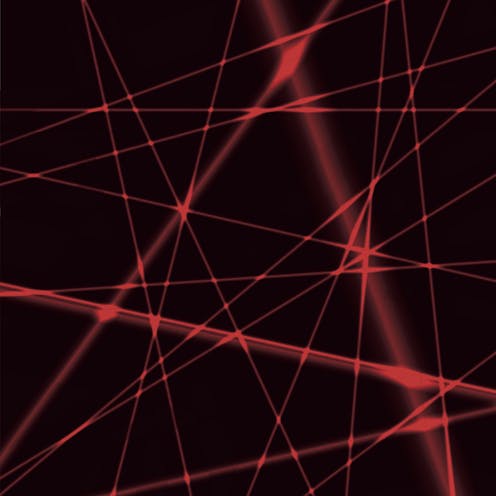
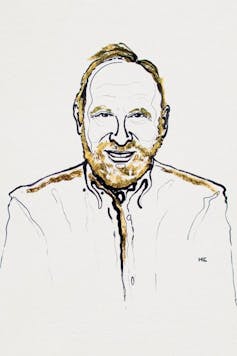
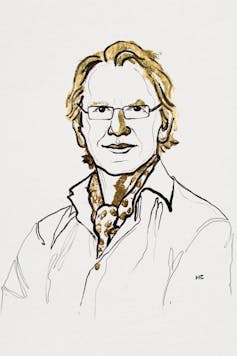
Our world is full of light and we depend upon it to power life on our planet. So it is appropriate to honor three scientists who invented new ways of using light rays to explore our world.
The 2018 Nobel Prize in Physics was awarded to Arthur Ashkin, Gérard Mourou, and Donna Strickland for developing tools made from light beams. Ashkin won half of the prize for his work on optical tweezers, which are beams of light that can actually manipulate tiny objects like cells or atoms, while Mourou and Strickland won the other half for creating technology that generates high intensity, ultra-short laser pulses, which are used for eye surgeries, material sciences, studies of very fast processes and plasma physics among others.
Alfred Nobel specified in his will that the physics prize should be awarded for “the most important discovery or invention within the field of physics” so as a physicist I think he’d be pleased that this year’s award recognizes inventions made in the 1970s and 1980s that have led to practical applications that benefit mankind.
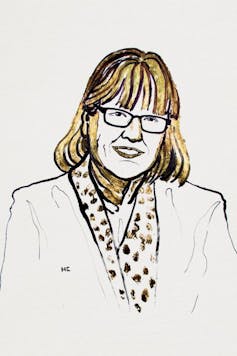
Donna Strickland is only the third woman to win the Nobel Prize in Physics, out of 210 recipients, and the first since 1963. Marie Curie was the first in 1903; She won another one in 1911 for chemistry. Maria Goeppert-Mayer was the second. Hopefully in the future the Nobel Prize committee can lower the average of 60 years between women laureates being named.
What are optical tweezers?
Using light to manipulate our world has become very important in science and medicine over the past several decades. This year’s physics Nobel recognizes the invention of tools that have facilitated advances in many fields. Optical tweezers use light to hold tiny objects in place or measure their movement. It may seem odd that light can actually hold something in place but it has been well known for more than a century that light can apply a force on physical objects through what is known as radiation pressure. In 1969, Arthur Ashkin used lasers to trap and accelerate micron sized objects such as tiny spheres and water droplets. This led to the invention of optical tweezers that use two or more focused laser beams aimed in opposite directions to attract a target particle or cell toward the center of the beams and hold it in place. Each time the particle moves away from the center, it encounters a force pushing it back toward the center.
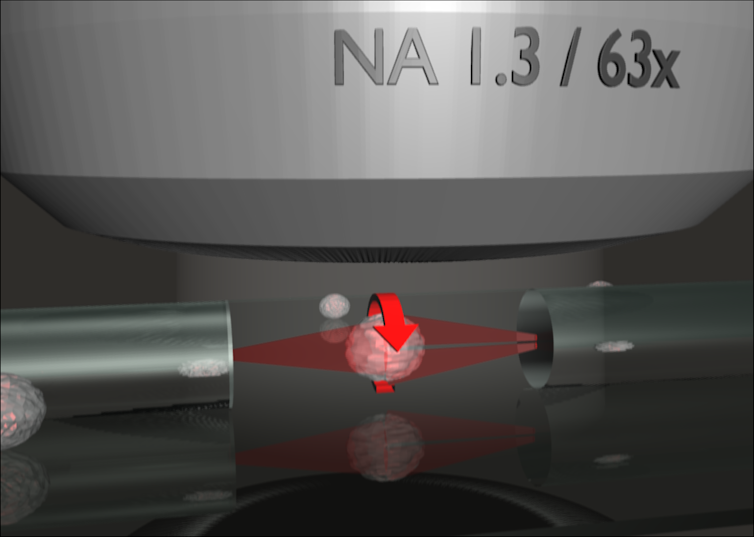
Steven Chu, Claude Cohen-Tannoudji and William D. Phillips won the 1997 Nobel Prize in Physics for development of laser cooling traps, known as optical traps, that hold atoms within a confined space. Askhin and Chu worked together at Bell Laboratories in the 1980s laying the foundation for work on optical traps. While Chu continued work with neutral atoms, Ashkin pursued larger, biological targets. In 1987, Ashkin used optical tweezers to examine an individual bacterium–without harming the microbe. Now optical tweezers are routinely used in studies of molecules and cells.
Ashkin earned his bachelor’s degree from Columbia University and his Ph.D. from Cornell. He started at Bell Laboratories in 1952 and retired in 1992. But he assembled a home laboratory to continue his scientific investigations. He has been awarded more than 45 patents.
Why are fast laser pulses important?
Gerard Mourou and Donna Strickland worked together at the University of Rochester where they developed the technique called chirped pulse amplification (CPA) for laser light. Strickland was a graduate student and Mourou was her thesis advisor in the mid-1980s. At the time, progress on creating brighter lasers had slowed. Stronger lasers tended to damage themselves. Strickland and Mourou invented a way to create more intense light, but in short pulses.
You are probably most familiar with laser pointers or barcode scanners which are just some of the ways we use lasers in everyday life. But these are relatively low intensity lasers. Many scientific applications need much stronger ones.
To solve this problem Mourou and Strickland used lasers with very short (ultrashort) pulses – quick bursts of light separated in time. With CPA, the pulses are stretched in time, making them longer and less intense, and then the pulses are amplified up to a million times. When these pulses are compressed again (through reversing the process used to stretch), the pulses are much more intense than can be created without the CPA technique. As an analogy, consider a thick rubber band. When the band is stretched, the rubber becomes thinner. When it is released, it returns to its original thickness. Now imagine that there is a way to make the stretched rubber band thicker. When the band is released, it will end up thicker than than the original band. This is essentially what happens with the laser pulse.
There are a variety of ways the stretching and amplification can be done but nearly all of the highest power lasers in the world use some variation of this technique. Since the invention of CPA, the maximum intensity of new lasers has continued a dramatic rise.
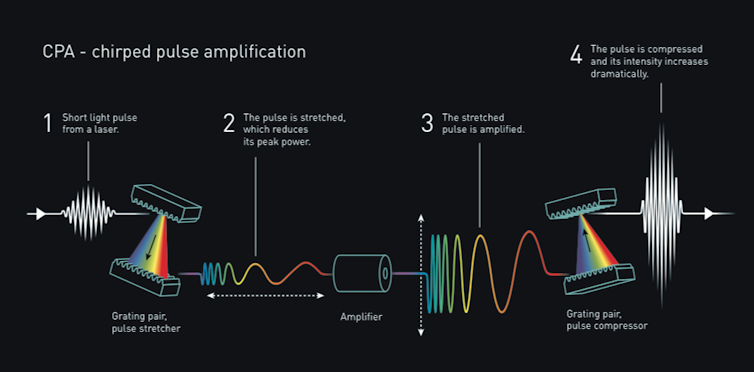
In my own field of particle physics, CPA based lasers are used to accelerate beams of particles possibly providing a path to greater acceleration in a shorter distance. This could lead to lower cost, high-energy accelerators that can push the bounds of particle physics – enabling us to detect evermore elusive particles and gain a better understanding of the universe.
But not all particle accelerators are behemoths like the Large Hadron Collider which has a circumference of 17 miles. There are some 30,000 industrial particle accelerators worldwide that are used closer to home for material preparation, cancer treatment, and medical research. Mourou and Strickland’s work may be used to shrink the size of these accelerators making them smaller and cheaper.
Ultrafast, high-intensity lasers are also now being used in eye surgery. It can be used to treat the cornea (surface of the eye) to improve vision in some patients. The CPA invention is also used in attosecond science for studying ultrafast processes. An attosecond is one million trillionth of a second. By having lasers that produce pulses every attosecond, we can get a snapshots of extremely fast processes such as atoms losing an electron (ionizing) and then recapturing it.
The 2018 Nobel Prize in Physics shines a light on the pioneering work of these three scientists. Over the past three decades their inventions have created avenues of science and medical treatments that were previously unattainable. It is certain that we will continue to benefit from their work for a long time.
Todd Adams receives funding from the U.S. Department of Energy.
Read These Next
West Coast levee failures show growing risks from America’s aging flood defenses
Levees protect more than 7 million buildings in the US today, yet they got a D-plus grade in 2025. A…
LA fires showed how much neighborliness matters for wildfire safety – schools can do much more to te
Managing fire risk is about more than regulations and rules. It’s also about caring for neighbors…
Has the Fed fixed the economy yet? And other burning economic questions for 2026
As 2026 begins, uncertainty is at the top of everyone’s mind.






